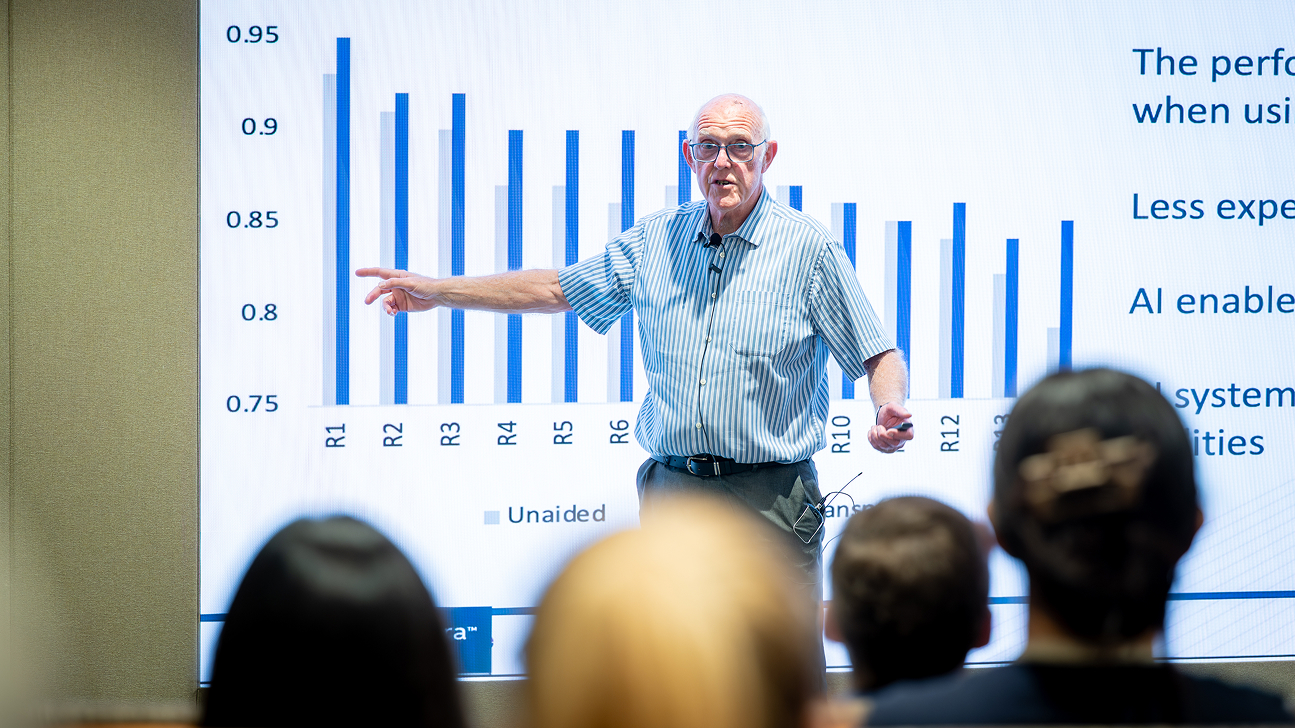Six predictions for how AI will evolve in 2025
Thursday, February 13, 2025

As we celebrate UAE Innovation Month, under the banner ‘UAE Innovates 2025’, our Provost and Professor of Natural Language Processing, Tim Baldwin, looks at some of the innovations, advances and challenges we could see in the remainder of this year.
We are barely into February and already 2025 is on its way to becoming an extremely eventful and consequential year for artificial intelligence.
Last month, OpenAI, Oracle and SoftBank announced a massive $500 billion initiative to build AI infrastructure. Meanwhile, a Chinese AI lab called DeepSeek released R1, an open-weight reasoning model that was shown to perform almost as well as current frontier models, including OpenAI’s o1, at a fraction of the cost. In a paper describing the model, researchers from DeepSeek claimed that R1 attained this level of performance in part by building upon open models from Meta and Alibaba. Days later, OpenAI released o3-mini, a cost-efficient model in their reasoning series that matched or surpassed o1’s accuracy.
All of this is to say that AI is a dynamic and rapidly evolving field. What does tomorrow hold? It’s anyone’s guess. But here are six predictions I have for new advances and challenges we may see in the rapidly evolving world of AI for the remainder of 2025.
Agentic AI gets to work
Today, most people who use AI systems, such as large language models (LLMs), interact with them by typing in text or speaking to them. Outputs of these systems are also in the form of text or speech. We are now, however, entering a new phase in the trajectory of AI where systems will begin to take direct actions on behalf of users.
2025 will be a breakout year for agentic AI: AI agents that interact directly with other systems, and hence are able to perform actions on behalf of the user. These agents are designed to process prompts from users, figure out an appropriate action, and complete a task. This is what Siri, Alexa, and other smart devices were promised to be years ago but failed to deliver on, other than through trivial tasks like setting timers.
Agentic AI systems combine planning and action, and have the potential to provide massive benefits to people. Say, for example, you want to go on holiday to Europe with your family, making stops in several cities. Your kids want a hotel with a big pool while you and your partner want one within walking distance of the best restaurants. Instead of spending hours researching hotels that fit these criteria, evaluating the options and making the bookings on different websites, an agentic AI system could do all this work for you. Sounds nice, doesn’t it?
It is, in theory. But as a researcher who is heavily invested in AI safety, I also believe that it’s difficult to anticipate the outcomes of agentic AI systems, and their deployment needs to be pursued with care.
Agentic AI systems use LLMs and other foundation models to make sense of user prompts. They also use LLMs to learn how to interact and work with other systems by reading their documentation — just as we would do ourselves. This is a major challenge because modern-day models don’t have the fine-grained control or transparency to accurately predict the downstream effects of agentic AI systems built on them. So, in addition to gains in efficiency and convenience, I also foresee spectacular examples of agentic AI going off the rails.
In some ways, this is nothing new. We have seen cases where AI systems were released to the public and didn’t perform as expected — think of last year’s glitches during the launch of Google’s Gemini vision-language model. The potential harms brought about by naively designed agentic AI, however, are far greater, and have direct implications for the user.
AI safety is hard enough when dealing with tools like LLMs that input and output text. These systems are confined to their own textual sandbox, so to speak, but the stakes get higher once we connect agents to other systems that have real world impact. We will see incredible progress with agentic AI. But it is also our responsibility to build safeguards to prevent cataclysmic outcomes, and our understanding of how to achieve this is still limited.
Increased control of embodied AI systems with foundation models
We’re suddenly reaching a point where we will be able to control embodied AI systems — robots, broadly construed — using LLMs and other foundation models. This is similar to where we stand today with agentic AI. But instead of an AI agent leveraging foundation models to control other systems via APIs, we will use foundation models to control physical devices.
When most people talk about agentic AI, they are talking about agents connected to software systems such as travel booking or banking systems via APIs. People who study robotics, however, are interested in developing ways to control physical devices via APIs. Technologically, the differences between these concepts aren’t great. But the implications are huge, and the result will be a collapsing of meaningful differences between digital-only systems and embodied ones.
I don’t anticipate that all of our devices will be able to talk with each other, but I envision strong convergence between robotics and agentic AI systems.
There are massive opportunities to improve generalizability for embodied AI
A major challenge researchers face with embodied AI is how to harness the sorts of scaling laws that have been driving the incredible advances in fully virtual systems like foundation models. While the data that is used to train foundation models — speech, text, images, and video — is representative of the world, it isn’t actually tied to it. To some extent, robots can be trained with this ungrounded data, but at some point, they need to act in the environment in which they will be used and gain real-world feedback.
The challenge is that these systems can’t simply ingest huge amounts of data and do parallel processing on real-world data because it’s not possible to speed up real-world time. Unlike in virtual environments, this training and testing can only happen at the speed at which our world operates.
That said, we will see significant innovations to address this problem in the coming year. Mass sampling across independent devices can provide meaningful information about how machines interact with their environments, providing the right learning signal for robots to do specific tasks. Perhaps more important, this approach can provide machines with general insights about how to behave.
This kind of generalizability is essential because once robots begin to be used in the world, they will continually encounter situations and environments for which they weren’t explicitly trained.
One can imagine a scenario in which a robot needs to pick up a strawberry even though it has never seen one before. The robot would be guided by generalized knowledge it has about grasping different objects to make an on-the-fly assessment about how firmly it should grasp the fruit without crushing it. This kind of generalizability is a critical requirement once embodied AI systems move out of highly controlled environments like manufacturing facilities and warehouses, and into the real world.
It’s also an exciting area of research because generalizability is an AI-complete problem that requires insights from researchers in a wide variety of areas such as natural language processing, computer vision, and human-computer interaction. It has real potential to change the world.
AI will be an accelerant for scientific discovery
Last year, Demis Hassabis and John Jumper of Google DeepMind were awarded the Nobel Prize in Chemistry for AlphaFold2, a system that predicts the structure of proteins based on the sequence of their amino acids. This was a major development in the life sciences that will have implications for scientific research for decades. This year, I expect other major developments in the life sciences that go well beyond Hassabis and Jumper’s substantial contribution.
Bioinformatics will be dramatically transformed by AI in terms of speed and fidelity of modeling. Scientists will be able to make predictions about biological processes faster and more accurately, potentially reducing the time it takes to develop new treatments and medicines — with the caveat that it typically takes years to bring medicines through clinical trials.
We will also see an expansion of the kinds of work AI models do in the life sciences. While predicting the structure of a protein is extremely valuable for scientists, it’s also very specific. New models will be released that are trained over multiple levels of biological data, such as genomics and proteomics, all the way up the “biology stack”.
These systems will be used to simulate organs, or even organisms as a whole. The impact of these systems will be phenomenal. This work has already started: MBZUAI President and University Professor Eric Xing, along with other researchers at the university, recently published a study that proposes a new way of modeling biology through a network of integrated foundation models. Their research was profiled in The Atlantic.
While AI and data science have long been used in the life sciences, we are now poised for major developments that will explode in scope. I also foresee more adoption of AI in chemistry and in the development of new mathematical theory and proofs. I don’t believe that AI will generate great insights on its own without input by humans, but it will be an accelerant for scientific findings, with scientists always in the loop.
Universities will become more attractive for the world’s top scientists
Big tech has made massive investments in AI over the past decade, attracting some of the best talent. But researchers who work for the world’s largest tech companies are limited in what they can share about their research. Big tech is mostly a closed shop and the secretive nature of these companies has become exacerbated over time.
There’s a reason for this, of course. Companies need to protect their intellectual property to maintain a market edge, and in software this is mostly done through closely guarding engineering details. But I foresee an exodus from industry. More and more people will see the secretive nature of these companies as a turn off — aside from the great financial incentives they receive working there.
There are also many researchers who don’t want to be just another name among thousands in a massive team, and not be able to talk about their contribution to a project. Most people who get into leading roles in the AI industry do so by getting a Ph.D., which involves close engagement with a research community and open sharing of ideas and findings. I think a lot of people struggle with not being able to maintain engagement with this community, and the loss of the self-fulfillment of seeing others use and build on their ideas.
As scientists, we always think of ourselves as standing on the shoulders of others. Universities and other research institutions provide an environment in which people can engage with their colleagues, openly publish their research, and release their models. This is why universities like MBZUAI are becoming more attractive for the world’s top AI researchers.
In tandem with this, we are already seeing more small and mid-sized startups working on open models that rival those of the leading US AI companies on specific tasks. These companies might not be directly competing with the largest companies, but their researchers can tell the world about their work, engage directly with end users, and learn from their experiences.
It will be a year of greater diversification in the AI ecosystem
Broadly speaking, I believe we will see more focus on sovereign AI capabilities through investment by individual countries, to ensure they are not beholden to the world’s big tech companies. We will also see new and better hardware, including GPUs, produced by smaller companies. And we will see more powerful, specialized models trained on this new hardware.
In the field of AI, as in life, the only constant is change. We have seen in a few short weeks that 2025 is on pace to be a consequential year for AI. I’m most confident predicting that this trend will continue apace throughout the year.
Related
K2: An open source model that delivers frontier capabilities
MBZUAI’s Institute of Foundation Models has released its latest version of K2 – a 70-billion-parameter, reasoning-centric foundation model.....
Read MoreWhy 3D spatial reasoning still trips up today’s AI systems
A new benchmark by MBZUAI researchers shows how poorly current multimodal methods handle real-world geometric and perspective-based.....
- 3D ,
- spatial reasoning ,
- Vision language model ,
- benchmark ,
- neurips ,
- conference ,
- research ,
Sir Michael Brady on why healthcare AI must move from detection to articulation
Speaking as part of MBZUAI’s Distinguished Lecture series, Sir Michael Brady discussed the future of healthcare and.....
- healthcare ,
- computer vision ,
- causal reasoning ,
- oncology ,
- on campus ,
- guest lecture ,
- medicine ,


